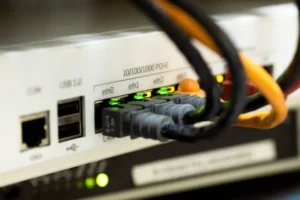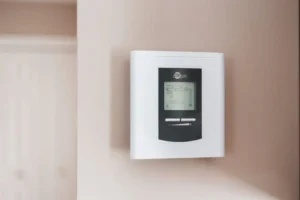Now Reading: How Much Home Internet Data Do I Need?
- 01
How Much Home Internet Data Do I Need?
- Home
- Home Internet
- How Much Home Internet Data Do I Need?
How Much Home Internet Data Do I Need?
![]() Anne MaddisonHome InternetAugust 6, 202567 Views
Anne MaddisonHome InternetAugust 6, 202567 Views

If you’re not sure how much internet data you need at home, you’re not alone. Many people sign up for internet plans without knowing what they actually use each month. Some get too little and end up with slow speeds or extra charges. Others pay for more than they need.
Understanding your internet data usage is easier than it sounds. It’s just about knowing what activities use the most data and how often your household does those things. Watching movies in HD, joining video calls for work, playing online games, or even having smart devices running in the background all use data in different ways.
In this guide, we’ll break it all down in simple terms. We’ll go over what data usage really means, how much data common tasks use, how to estimate your household’s needs, and tips to manage your usage. Whether you live alone, with roommates, or have a family that streams and games all day, this guide will help you figure out the right amount of data for your home.
Let’s start with the basics.
What Is Internet Data Usage?
Internet data usage is the amount of data you use when you do anything online. Every time you watch a video, scroll through social media, play a game, or download a file, you’re using data. It doesn’t matter if you’re on a computer, phone, smart TV, or tablet. If the device connects to the internet, it’s using data.
Some things use a little data, like checking email. Others, like watching Netflix in 4K, use a lot more. The more devices you have online at the same time, the more data you’ll use overall. Even when you’re not actively doing something, some devices may still use data in the background. This is called background data, and it can add up if you’re not aware of it.
There are two types of data usage: downloads and uploads.
Download is when data is coming to your device. This happens when you stream a movie, scroll through Instagram, or download a game. Most of your internet usage is in the form of downloads.
Upload is when data goes from your device to the internet. This happens when you send an email with an attachment, post a video, or join a video call. Uploading is just as important for some people, especially if you work from home or create online content.
Your internet plan may show two speeds: one for downloading and one for uploading. Usually, the download speed is much higher because we use it more.
How Home Internet Data Works
When you pay for home internet, your provider gives you a certain amount of data to use each month. This is similar to how mobile data works on your phone. Some plans come with unlimited data, while others have monthly data caps. Understanding how this works can help you avoid slowdowns or surprise fees.
It is important to note that internet data is usually measured in megabytes (MB), gigabytes (GB), and terabytes (TB).
- 1 MB is about 1,000 kilobytes
- 1 GB is about 1,000 MB
- 1 TB is about 1,000 GB
Monthly Data Caps (Unlimited vs Limited)
A data cap is the maximum amount of internet you are allowed to use each month. Once you reach that limit, your provider might slow down your speed, charge extra fees, or stop your service until the next billing cycle. Not all internet providers have data caps, but many still do.
Here is how they usually work:
- Limited data plans come with a cap, like 1 TB per month. If your household streams a lot or has many devices, it is easier to hit the cap than you might think.
- Unlimited data plans do not have strict limits. You can stream, download, and browse as much as you want. These plans are often more expensive, but they give you peace of mind if your household uses a lot of internet.
How Much Data Do Common Activities Use
Every time you go online, you’re using internet data. Whether you’re watching videos, listening to music, or just scrolling through social media, it all adds up. Some activities use very little data, while others can burn through your monthly limit quickly. If you’re trying to figure out how much data your household really needs, it helps to understand how much each activity typically uses.
Here’s a breakdown of how much data different online activities use per hour:
Activity | Estimated Data Per Hour |
Web browsing | 60 MB |
Streaming music | 150 MB |
Video calls (Zoom, Skype) | 500 MB to 1.5 GB |
HD video streaming | 3 GB |
4K video streaming | 7 to 10 GB |
Online gaming | 50 to 200 MB |
Software updates | Varies, often 1 to 5 GB |
Smart home devices (total) | 5 to 50 MB per hour |
Estimate Your Household’s Data Needs
Not every household uses the internet the same way. Some people only check email and watch a few videos. Others stream movies all day, play online games, and have a dozen smart devices running in the background. To figure out how much data you need, you have to think about the number of people in your home, how they use the internet, and what devices they’re using.
Single Person vs. Family Usage
A single person living alone usually needs much less data than a family of four. If you’re just browsing the web, streaming a few shows at night, and using your phone, you might only need 300 to 500 GB a month.
Now take a family of four. Each person has their own phone. There’s a smart TV, a few tablets, maybe a game console or two. Everyone wants to stream, play, or scroll at the same time. That could push your monthly usage closer to 1 to 2 TB, especially if the kids stream in HD or 4K.
Devices in the Home
The number and type of devices you have matters a lot. Here’s what to think about:
- Smartphones use data all the time, especially for video, social media, and cloud backups.
- Smart TVs and streaming sticks can use several gigabytes per hour depending on video quality.
- Gaming consoles don’t use much while playing, but downloading a new game or an update can use 50 GB or more in one go.
- Smart home devices like thermostats, doorbells, and speakers use less data, but if you have a lot of them running all day, it adds up.
- Laptops and desktops are often used for work, school, and entertainment. If you’re on video calls or downloading files, your data use will increase.
Work-from-Home Impact
If someone in your house works from home, your internet usage is going to be higher. Video meetings, file sharing, cloud apps, and even background syncing all use data. A person working from home full-time might use an extra 100 to 300 GB per month just from work-related activities. And it’s not just during the day. If that person also relaxes by watching Netflix or gaming, you need to factor that in too.
Kids and Streaming Habits
Kids can use a lot of data without even realizing it. Watching cartoons in HD or 4K on YouTube or Netflix every day adds up fast. So do video games with large updates. Even educational apps or online classes can use more data than you’d expect. Tablets that stream all day or download big apps can make a big dent in your monthly allowance. If you have more than one child, the usage multiplies quickly.
Data Usage Scenarios by Household Size
Trying to guess how much data you need? It helps to think in terms of real-life situations. Below are different types of households based on how they typically use the internet. This will give you a better idea of what kind of data plan you might need.
Light Users (Emails, browsing, occasional video)
Light users don’t spend a lot of time online. Maybe they check emails, read the news, scroll through social media, and watch a short video now and then. There’s no streaming in 4K, no big downloads, and no smart home system constantly running in the background.
Estimated monthly data use: 100 to 250 GB
Moderate Users (Daily streaming, video calls)
Moderate users are more active online. They might stream Netflix shows every night in HD, hop on a few Zoom calls, and scroll through videos on social media throughout the day. They might also have a few smart devices at home, like a video doorbell or smart speaker.
Estimated monthly data use: 300 to 700 GB
Heavy Users (Multiple streamers, remote work, gaming)
Heavy users rely on the internet for almost everything. One or more people work from home. Someone is always streaming video, whether it’s in HD or 4K. Maybe there’s an online gamer in the mix who also downloads large updates or games. Smart TVs and multiple phones are always connected.
Estimated monthly data use: 800 GB to 1.5 TB
Very Heavy Users (4K streaming, smart home, downloads)
These households are always online. They stream in 4K across several TVs, have smart devices in every room, download large files regularly, and often back up data to the cloud. Multiple people may work or study from home. Almost every device is connected at all times.
Estimated monthly data use: 2 TB or more
Common Ways to Monitor Your Internet Data Usage
If you want to avoid going over your data limit or just stay aware of how much you’re using, it helps to track your data. The good news is that you don’t need to guess. There are simple ways to monitor your internet usage, depending on what tools you already have.
Router-Level Tracking
Many modern routers let you track internet usage directly. You can log in to your router’s dashboard using a web browser. From there, you might see total data usage for the day, week, or month. Some routers even break it down by device, showing which ones are using the most data.
ISP Apps and Dashboards
Most major internet providers like Xfinity, AT&T, and Spectrum offer free apps or online dashboards. These let you log in and see how much data your home has used each billing cycle. Some also send alerts if you’re getting close to your cap.
If you’re noticing strange internet behavior or unexpected slowdowns, it might be worth checking for the signs your home router might be hacked. Knowing what to look for can help you stay protected.
Tips to Save Internet Data
You don’t always need to upgrade to a more expensive internet plan just because you’re hitting your data cap. Sometimes, a few small changes in how you use the internet can make a big difference. Here are some simple but effective tips to help reduce data usage at home without making life less convenient.
Lower Streaming Quality
Streaming video is one of the biggest data hogs in any household. Watching a movie in 4K can use more than 7GB per hour, while standard definition (SD) only uses around 1GB per hour. If you don’t really need that ultra-sharp picture, lower the video quality in your streaming app settings. Many platforms like Netflix, YouTube, and Hulu let you adjust playback settings manually.
Tip: On smaller screens like tablets or phones, the difference between HD and SD is barely noticeable.
Turn Off Auto-Updates
Software updates for apps, games, and devices can use a lot of data, sometimes several gigabytes at a time. If auto-updates are turned on, these downloads can happen in the background without you even knowing.
To save data:
- Set apps and devices to ask before updating
- Schedule updates for times when you’re connected to unlimited internet
- On game consoles, pause or delay game updates you do not need right away
Note: Saving data is a good habit, but not at the cost of your security. Devices like phones, tablets, laptops, and routers often get important security updates. If you can, connect to unlimited data and download these updates as soon as possible. You can also choose to keep auto-updates turned on for security-related items. It is better to stay protected, especially for devices that go online every day.
Use Offline Mode Where Possible
Many apps offer offline modes to help you save data. For example, you can download playlists on Spotify or Netflix shows ahead of time while connected to Wi-Fi. Then, you can watch or listen without using any more data.
Monitor Background Data on Smart Devices
Smart home devices like security cameras, voice assistants, and even smart plugs can quietly use data all day long. On their own, the amount is small. But if you have many devices running at once, the usage can add up over time.
To reduce unnecessary data use:
- Turn off features you don’t need
- Set security cameras to upload only when motion is detected (just make sure this setting still meets your security needs)
- Use energy-saving or away modes when no one is home
Note: Before changing your camera settings, make sure the new setup still gives you the level of security you need. Disabling continuous uploads may lower data use but could also reduce coverage.
Final Thoughts: Choose the Right Plan for Your Needs
Understanding how much internet data you use is one of the best ways to avoid slowdowns, overage fees, or paying for more than you actually need. Every household is different. A single person streaming videos a few hours a week won’t use as much as a family with kids gaming, parents working from home, and smart devices running all day.
To quickly recap:
- Most online activities use some form of data, whether you’re watching videos, browsing, or updating apps.
- Data is usually measured in MB, GB, or TB, and your internet plan may have a monthly cap.
- Streaming, video calls, and software downloads use the most data.
- Households with more people or more devices will need more data.
- You can save data by lowering streaming quality, turning off auto-updates, and using offline modes.
If you’re unsure how much data you actually use, start by tracking it through your router or ISP’s app. You can also check your device settings or use third-party tools to get a clearer picture. There are also online data calculators that let you estimate your monthly usage based on your habits. These tools can help you choose a plan that fits your needs without going over or wasting money.
Most importantly, don’t set it and forget it. Your internet habits can change over time. Maybe you started working from home, got a new smart TV, or your kids are spending more time online. Make it a habit to check your usage every few months and adjust your plan or habits if needed.
Choosing the right internet plan is not just about speed. It’s also about how much you can use. With a little knowledge and some tracking, you’ll be able to get the most out of your internet without going over your limit.
Previous Post
Next Post
Climate ControlJuly 27, 2025
What Air Conditioner Size Do I Need?
Home AppliancesJuly 28, 2025
Can Air Conditioner Make You Sick?
Home AppliancesAugust 24, 2025
Are Home Air Conditioner Tune Ups Necessary
Home AppliancesAugust 23, 2025
Can Air Conditioning at Home Trigger Asthma?
- 03
Home AppliancesJuly 27, 2025
What Air Conditioner Size Do I Need?
- 04
Climate ControlJuly 28, 2025
Can Air Conditioner Make You Sick?




















